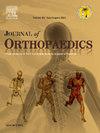匹配线与设计:全髋关节置换术中短股柄的一种新的放射学指标
IF 1.5
Q3 ORTHOPEDICS
引用次数: 0
摘要
在全髋关节置换术(THA)中,匹配系统设计和股骨形态以平衡稳定性和骨整合与并发症风险是至关重要的。一些历史放射测量有助于外科医生为患者选择最佳的干细胞设计。由于这些测量是为较长的茎(>;150毫米)开发的,因此它们对较短的茎(<;120毫米)的效用较小。本研究评估了一套新的放射学测量方法,适合于较短的茎干,以及几种中外侧(ML)和干骺端填充(MF)茎干的相对放射学表现。方法回顾性队列研究2011年1月至2020年8月在同一所医院进行的所有选择性初级tha。患者接受短时间的干骺端介入治疗和至少6个月的标准化x线片随访。根据验证的参考点创建了六个射线照相指数。术后x线片评估骨长入和透光区稳定固定。结果748例,平均年龄63(±12.2)岁。13.6%的茎有明显的辐射透光性。干骺端填充茎的放射率发生率低于ML茎(9.1% vs 19.3%, p <;0.001)。干骺端Flair指数(MFI)低于0.6和小皮质指数(LCI)高于0.3显著预示较高的放射率(p <;0.001)。LCI为0.3或更高的患者在使用ML系统时,有93%的可能性出现放射率(p <;0.001)。结论MFI和LCI两项指标预测现代短股干骨融合面积。干骺端填充茎的透光率比ML茎低。由于放射率的概率较高,外科医生应考虑避免LCI值高于0.3的患者的ML干。本文章由计算机程序翻译,如有差异,请以英文原文为准。
Matching lines to designs: A novel radiographic index for shorter femoral stems in total hip arthroplasty
Introduction
Matching stem design and femoral morphology to balance stability and osseointegration with complication risk is critical in total hip arthroplasty (THA). Several historical radiographic measurements have assisted surgeons in selecting the best stem design for a patient. As these measurements were developed for longer stems (>150 mm) they have less utility for shorter stems (<120 mm). This study evaluated a set of new radiographic measurements tailored to shorter stems and the relative radiographic performance of several medial-to-lateral (ML) and metaphyseal-filling (MF) stems.
Methods
Retrospective cohort study on all elective primary THAs between January 2011 and August 2020 at a single institution. Patients received a short metaphyseal-engaging stem and a minimum six-month follow-up with standardized radiographs. Six radiographic indices were created based on validated reference points. Postoperative radiographs were evaluated for stable fixation by bone ingrowth and lucent zones.
Results
There were 748 cases, with a mean age of 63 (±12.2) years. Radiolucencies were evident in 13.6 % of stems. Metaphyseal-filling stems had a lower incidence of radiolucencies than ML stems (9.1 vs 19.3 %, p < 0.001). A Metaphyseal Flair Index (MFI) below 0.6 and a Lesser Cortical Index (LCI) above 0.3 significantly predicted higher rates of radiolucency (p < 0.001). Patients with an LCI of 0.3 or higher had a 93 % probability of developing radiolucencies when using ML stems (p < 0.001).
Conclusion
Two indices (MFI and LCI) predicted areas of osseointegration in modern short femoral stems. Metaphyseal-filling stems have lower radiolucency rates than ML stems. Due to the higher probability of radiolucencies, surgeons should consider avoiding ML stems in patients with LCI values above 0.3.
求助全文
通过发布文献求助,成功后即可免费获取论文全文。
去求助
来源期刊

Journal of orthopaedics
ORTHOPEDICS-
CiteScore
3.50
自引率
6.70%
发文量
202
审稿时长
56 days
期刊介绍:
Journal of Orthopaedics aims to be a leading journal in orthopaedics and contribute towards the improvement of quality of orthopedic health care. The journal publishes original research work and review articles related to different aspects of orthopaedics including Arthroplasty, Arthroscopy, Sports Medicine, Trauma, Spine and Spinal deformities, Pediatric orthopaedics, limb reconstruction procedures, hand surgery, and orthopaedic oncology. It also publishes articles on continuing education, health-related information, case reports and letters to the editor. It is requested to note that the journal has an international readership and all submissions should be aimed at specifying something about the setting in which the work was conducted. Authors must also provide any specific reasons for the research and also provide an elaborate description of the results.
 求助内容:
求助内容: 应助结果提醒方式:
应助结果提醒方式:


